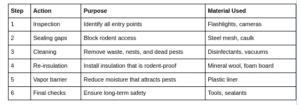Key Takeaways
- It is vital to Crawl Space Rodent Proofing to avoid damage to insulation and stop parasites from moving inside the home.
- Rodent-proof insulation like foam and mineral wool will last much longer, and sand similarly repels pests much better than conventional materials.
- There are also undeniable signs to rodents, such as bad smells would mean this is a good time for safe rodent removal and sealing.
- The do-it-yourself traps won’t be enough; a professional rodent proofing can assure that all rodents are out of your dwelling.
- If you have had the attic cleaned, you can get a complete home proofing from contamination while preserving energy consumption.
Rodents can damage your home’s foundation and health without you knowing. To get rid of them before it’s too late, you should rodent-proof your crawl space.
Did you know? According to Pestworld.org, rodents can give people more than 35 different diseases. A lot of these infections are spread by pests’ waste, pee, or even just dirty dust.
Imagine that these rodents live right under your floors. It’s real, yes. Because of this, rodent-proofing crawl space is not just a good idea, it’s essential.
Let’s talk about how to keep these sneaky intruders out of your home.
Why Crawl Spaces Are Rodent Hotspots
Most people ignore their crawl spaces. They’re quiet, damp, and dark, which makes them perfect for rodents to make nests and have babies. These bugs don’t just move in; they quickly take over.
Once they get inside:
- Tear up the insulation to make nests
- Chewing through electrical lines could lead to a house fire
- Leave poop and pee all over the place
- They bring fleas, ticks, and other bugs with them
The worst part? They might be there and you won’t even know it until it’s too late. Rodent proofing and regular maintenance are your first line of defence.
Clear Signs You Need Proofing Now
You don’t have to wait to act until there is a full infestation. In the beginning, look out for these signs:
- A musty or bad smell coming from under your floor.
- Sounds like scratching, chewing, or buzzing, especially at night.
- Fibreglass or wood beams that are broken up.
- Droppings and urine trails close to vents or ducts.
- Walls have little paw prints or smudges.
If any of these signs are present, it’s time for safe rodent removal and rodent-proofing.
Step-by-Step: How Crawl Space Proofing Works
To keep rodents out, you need a successful crawl space rodent proofing to make it safe, clean, and sealed.
Rodent-Proofing Process Table

All of these steps are necessary for lasting results.
Rodent-Proof Insulation: The Long-Term Solution
Want to keep mice and rats out for good? Start by putting up better insulation.
Fibreglass is used to insulate most houses. Rodents like to chew on it, shred it, and build nests in it, which is unfortunate.
That’s why experts now suggest rodent-proof insulation materials, like
- Mineral wool is too rough and itchy for rodents.
- Foam board (closed-cell) is dense and tough to chew.
- Reflective barriers keep out heat and keep pests away.
- Borate-treated cellulose is safe for people but deadly for pests.
This kind of insulation keeps your crawl area warmer, saves energy, and keeps rodents out. These are also great for attic cleaning and rodent proofing, so your whole house is safe.
Why You Should Avoid DIY Rodent Control
You might believe that setting traps is enough. But traps only catch the ones you can see. They don’t catch the ones that are hiding in your crawl space.
Safe rodent removal is about more than killing a few pests. It’s about:
- Finding all the possible entry points.
- Getting rid of nesting materials.
- Cleaning areas that are dirty.
- Changing insulation or wires that have been chewed on.
- Installing rodent barriers that really work.
Professionals who have been trained in rodent-proofing in Orange County know precisely how to keep rodents out for good.
Attic Cleaning and Rodent Proofing: A Must-Do Combo
Most of the time, air ducts and wall gaps connect your crawl area to your attic. Mice and rats don’t care what floor they’re on as long as it’s warm and dark.
If there are bugs in your crawl area, they might also be in your attic. That’s why a lot of people hire services for attic cleaning and rodent proofing, along with closing their crawl spaces.
This is what cleaning an attic includes:
- Getting rid of droppings and broken insulation.
- Cracks and gaps in the wall need to be sealed.
- Doing this will kill germs and get rid of smells.
- Installing rodent-proof insulation to stop reentry.
With this two-step plan, your whole house will become rodent-proof.
Top Benefits of Crawl Space Proofing
You’re getting rid of more than just pests when you do rodent-proofing of the crawl space. You are looking out for your whole family. Here’s how:
- No more toxins and dirty air.
- If you insulate your home, your HVAC system will work better and use less energy.
- There will be no more scratching sounds.
- A clean crawl area makes a house more appealing to buyers.
- Stop diseases spread by rodents at the source.
Don’t Wait, Protect Your Home Now!
Rodents won’t leave on their own. They will damage your property, multiply, chew wires, nest, and spread disease. Do something right away to keep pests out of your safe area.
Contact My Insulation Guy right away for the safest and most reliable rodent proofing. Our professionals can clean your attic or crawl space quickly, making your home disease-free and comfortable.
Visit our website or contact us to get more insightful information.
FAQs
Q1 How often should I look for my rodents in my crawl space?
Every six months or after a lot of rain, you should check. Rodents often enter when their surroundings change.
Q2 What is the best material for insulation that keeps rodents out?
The best choices are mineral wool and closed-cell foam boards. They don’t get chewed on and don’t encourage nesting.
Q3 Does rodent proofing only need to be done once?
Yes, if you do it right. Professionals seal all the joints, clean well, and use materials that will last.
Q4 Can rodents get through plastic or foam barriers?
They can get through foam or plastic that is soft. That’s why steel mesh and caulk are needed to keep rodents out of a crawl space.
Q5: How long does it take to keep rodents out of a crawl space?
Based on the damage and size of the house, most jobs are finished in one to two days.

